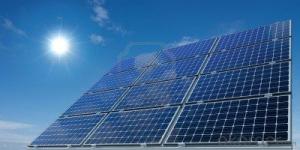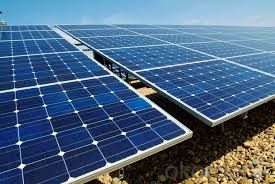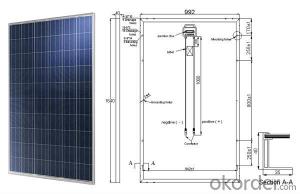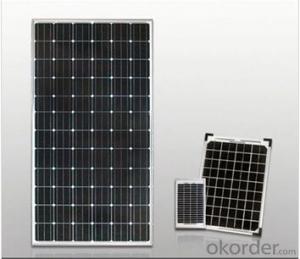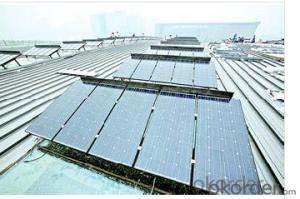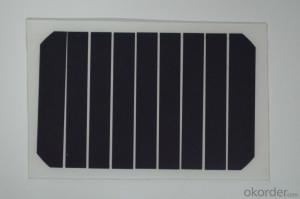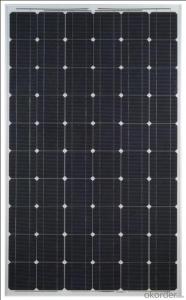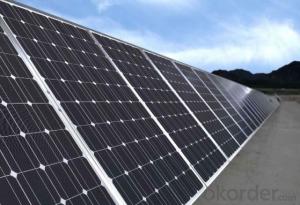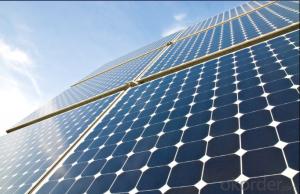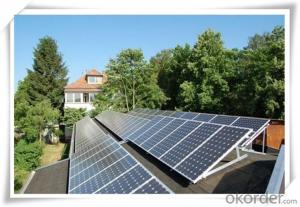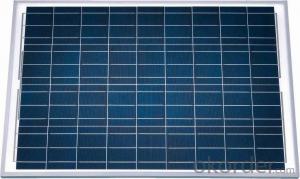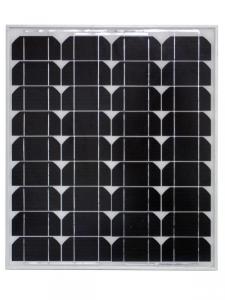Seg Solar Panels - Hot Sale 300W Monocrystalline Solar Panel with Good Quality CNBM
- Loading Port:
- Qingdao
- Payment Terms:
- TT OR LC
- Min Order Qty:
- 10 set
- Supply Capability:
- 300000 set/month
OKorder Service Pledge
OKorder Financial Service
You Might Also Like
Monocrystalline Solar Panel with 300W
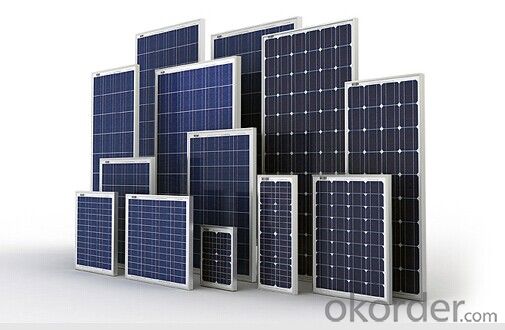
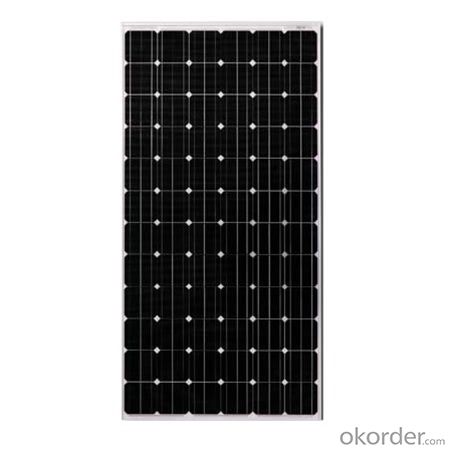
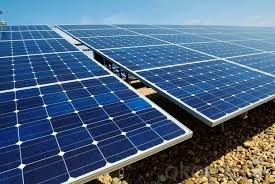
Monocrystalline Solar Modules
We offers a range of small, medium and large monocrystalline solar modules, designed for a range of requirements.
Specifications:
Tolerance | +/- 3% |
Cell | Monocrystalline silicon solar cells |
N0. of Cells | 72 (12 x 6) |
Dimension of Modules (mm) | 1581 x 809 x 40 |
Weight (kg) | 15.5 |
Limits:
Operating Temperature | -40~+85? |
Storage Temperature | -40~+85? |
Maximum System Voltage | 1000 VDC max. |
Hail Impact | Diameter of 28mm with impact speed of 86km/h |
Temperature and Coefficients:
NOCT | 48C+/-2? |
Voltage temperature coefficient (%/K) | -0.34 |
Current temperature coefficient (%/K) | 0.09 |
Power temperature coefficient (%/K) | -0.37 |
Characteristics:
Model: | SGM-160D | SGM-165D | SGM-170D |
Max-power voltage Vmp (V) | 34.5 | 35.4 | 35.8 |
Max-power current Imp (A) | 4.64 | 4.66 | 4.75 |
Open-circuit voltage Voc (V) | 41.75 | 43.6 | 43.32 |
Short-Circuit Current Isc (A) | 5.32 | 5.08 | 5.38 |
Max-power Pm(W) | 160 | 165 | 170 |
Model: | SGM-175D | SGM-180D | SGM-185D |
Max-power voltage Vmp (V) | 36.1 | 36.2 | 36.2 |
Max-power current Imp (A) | 4.85 | 4.97 | 5.11 |
Open-circuit voltage Voc (V) | 43.68 | 43.8 | 44.8 |
Short-Circuit Current Isc (A) | 5.49 | 5.48 | 5.51 |
Max-power Pm(W) | 175 | 180 | 185 |
STC: Irradiance 1000W/m2, Module temperature 25?, AM=1.5
Monocrystalline Solar Panels Specifications Range
Maximum Power (Pm) | Dimension | Weight | Operating Voltage (Vmp) | Operating Current (Imp) | Open Circuit Voltage (Voc) | Short Circuit Current (Isc) |
3W | 158x241x25mm | 0.5kg | 8.5V | 0.36A | 10.5V | 0.4A |
4W | 308x166x25mm | 0.77kg | 8.5V | 0.47A | 10.5V | 0.54A |
4W | 308.x166x25mm | 0.77kg | 16.8V | 0.24A | 21V | 0.27A |
5W | 296x215x25mm | 0.3kg | 16.8V | 0.48a | 21V | 0.54A |
10W | 286x406x25mm | 1.5kg | 16.8V | 0.59A | 21V | 0.66A |
12W | 286x406x25mm | 1.5kg | 16.8V | 0.71A | 21V | 0.8A |
14W | 286x541x25mm | 2kg | 16.8V | 0.83A | 21V | 0.96A |
16W | 286x541x25mm | 2kg | 17.2V | 0.93A | 21.5V | 0.99A |
18W | 296x541x25mm | 2.4kg | 18.8V | 1.07A | 21V | 1.2A |
20W | 296x641x25mm | 2.4kg | 17.2V | 1.15A | 21.5V | 1.24A |
24W | 541x451x25mm | 3.15kg | 16.8V | 1.14A | 21V | 1.56A |
26W | 541x451x25mm | 3.15kg | 17.2V | 1.51A | 21.5V | 1.63A |
30W | 296x966x25mm | 3.85kg | 16.8V | 1.78A | 21V | 2.03A |
36W | 541x641x35mm | 4.7kg | 16.8V | 2.14a | 21V | 2.4A |
40W | 541x641x35mm | 4.7kg | 17.2V | 2.33A | 21.5V | 2.5A |
55W | 1057x457x35mm | 6.6kg | 17.6V | 3.12A | 21.6V | 3.3A |
70W | 546x1196x35mm | 8.5kg | 16.8V | 4.15A | 21V | 4.7A |
75W | 546x1196x35mm | 8.5kg | 17.2V | 4.36A | 21.5V | 4.8A |
80W | 546x1196x35mm | 8.5kg | 17.6V | 4.55A | 21.6V | 4.9A |
110W | 1066x811x40mm | 11.8kg | 17.6V | 6.25A | 21.6V | 6.6A |
150W | 1066x811x40mm | 14kg | 34.4V | 4.36A | 43.2V | 4.7A |
- Q: I'm curious to know if the small solar panels on a calculator (ie TI-32) could produce a voltage similar to what is used in a single-use (disposable) camera, approximately 4V.
- It isn't Volts that matter if you're trying to put the calculator solar panel on the camera. It would be the amps. The calculator's solar panel will put out however many volts or very close to what the battery puts out. If you want you can test it out with a Volt/Ammeter. You see, those cameras use 2 double A batteries. They are going to put out a higher current than the small dime shaped battery in the back of your calculator; a higher voltage perhaps too. Those disposable cameras have a photo flash capacitor in them that has to charge. You can hear them charge up when you tell it to turn on the camera's flash. Sounds like a winding then the little orange light comes on. That light means the capacitor is charged. You SHOULDN'T be able to change out the batteries in the camera with a solar panel from a calculator without having to wait days for that flash capacitor to charge. Sorry. EDIT: HOWEVER, you can take multiple solar panels and wire them in a parallel circuit to get more current(amperes) or wire them in a series circuit to get a higher voltage. If you were to do this you could power whatever you wanted with them. Even your house if you were to get a rectifier to convert the power from DC to AC.
- Q: How much money can you save by using solar panels?
- The amount of money you can save by using solar panels depends on various factors such as your energy consumption, the size of your solar panel system, and the cost of electricity in your area. On average, homeowners can save anywhere from 40% to 70% on their electricity bills by switching to solar panels. However, it's important to consult with a solar energy professional to get an accurate estimate based on your specific circumstances.
- Q: Can solar panels be used in areas with high levels of dust or sandstorms?
- Yes, solar panels can be used in areas with high levels of dust or sandstorms. However, frequent and heavy exposure to dust or sand can reduce their efficiency over time. Regular cleaning and maintenance are necessary to ensure optimal performance in such areas. Additionally, advanced solar panel designs and coatings are being developed to mitigate the impact of dust and sand accumulation, making them more suitable for use in these challenging environments.
- Q: how much do you think it would cost for installation?i heard that solar panels can store electricity and any excess electricity gets sold back to the electric company. how much money can a home owner make from doing this?do you think solar panels are worth it?
- If you're in a sunny area, and the cost of electricity is high, solar panels can be worth it. But it's not a big moneymaker, it's something that pays back over long timeframes. We live in northern California, and our system is about break even, but that's because our electricity usage was low to begin with. If you want to see our system, look at the web page in my profile. Are panels worth it in your area? The only way to know for sure is to find a local installer in your phone book, and then ask for local references. If you can't find a local installer, that's a clue, and if they can't give you any references that are nearby, that's another clue. The panels don't actually store energy, the energy is sold back to the power company when what you produce is more than you consume, driving the meter backwards. Again, this is not a big moneymaker, and in fact, it may be impossible to make a profit, depending on your local laws.
- Q: Can solar panels be used to power an entire home?
- Yes, solar panels can be used to power an entire home. With the right number of solar panels and a proper energy storage system, it is possible to generate enough electricity to meet the energy needs of a household. However, it is important to consider factors such as energy consumption, geographical location, and system size to determine if solar panels alone can entirely power a home.
- Q: Can solar panels be used in disaster relief efforts?
- Yes, solar panels can be used in disaster relief efforts. They provide a reliable and sustainable source of electricity, allowing for the operation of critical equipment such as lights, phones, and medical devices. Solar panels can be quickly deployed in affected areas and can help reduce the reliance on fossil fuel-based generators, thereby reducing pollution and the need for fuel transportation.
- Q: Thinking about getting a solar panel installed but i'm worried about getting the govt. rebates. There is a Federal Tax credit and a State of Florida rebate and i'm wondering what the time frame is for getting the rebates. Has anyone gotten a solar panel installed recently that could give me more info.Thanks!
- In case you hadn't heard the state is broke.
- Q: How do solar panels affect property value?
- Solar panels can have a positive impact on property value by increasing the overall value of a property. Studies have shown that homes with solar panels tend to sell for a higher price compared to similar homes without solar installations. The energy savings and potential income from selling excess electricity to the grid can make a property more attractive to buyers, leading to a higher selling price and increased property value.
- Q: Its cloudy out and i have a solar panel that has 3, .5 volt cells But how do i charge it without sun any other ways?
- There okorder Why pay thousands of dollars for solar energy ($27,000 average cost) when you can build your own solar panel system for just a fraction of the retail cost. You can build a single solar panel or you can build an entire array of panels to power your whole house. Some people are saving 50% on their power bill, some people are reducing their bill to nothing. But what’s most impressive is that just by following these instructions some are even making the power company pay them!
- Q: Can solar panels be installed on drones?
- Yes, solar panels can be installed on drones. They can be used to harness solar energy and power the drone's onboard systems, increasing flight time and reducing reliance on traditional battery power. This technology is being explored for various applications, including surveillance, delivery services, and environmental monitoring.
Send your message to us
Seg Solar Panels - Hot Sale 300W Monocrystalline Solar Panel with Good Quality CNBM
- Loading Port:
- Qingdao
- Payment Terms:
- TT OR LC
- Min Order Qty:
- 10 set
- Supply Capability:
- 300000 set/month
OKorder Service Pledge
OKorder Financial Service
Similar products
Hot products
Hot Searches
Related keywords
